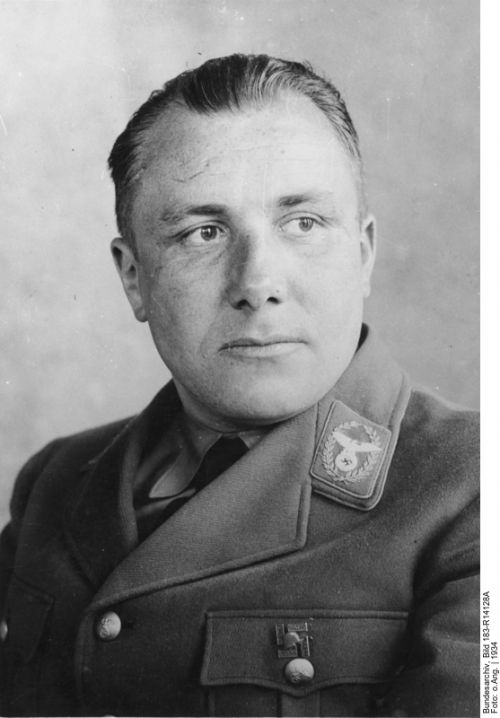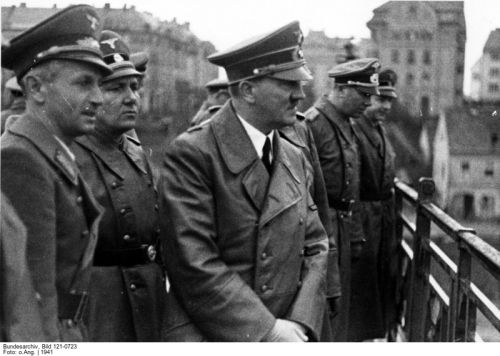Martin Bormann

Martin Bormann - (Bundesarchiv)
Martin Bormann was born on June 17, 1900, in Halberstadt, a town in the German state of Saxony- Anhalt.He was the son of a former Prussian regimental sergeant-major, who later became a post-office employee. Martin Bormann dropped out of school to work on a farming estate in Mecklenburg. After serving briefly as a cannoneer in a field artillery regiment at the end of the First World War, Bormann subsequently joined the Rossbach Freikorps in Mecklenburg and was connected with the so-called 'Feme' murders.
in March 1924, he was sentenced to one year's imprisonment as an accomplice of Rudolf Hoss in the brutal murder of Walther Kadow - his former teacher at elementary school, who had supposedly betrayed the proto - Nazi martyr Leo Schlageter to the French occupation authorities in the Ruhr. After his release Martin Bormann entered the Nazi Party, becoming the regional press officer in Thuringia and then business manager in 1928. From 1928, to 1930, he was attached to the SA Supreme Command and in October 1933, he became a Reichsleiter of the NSDAP. A month later he was elected as a Nazi delegate to the Reichstag. From July 1933, until 1941, Martin Bormann was the Chief of Cabinet in the office of the Deputy Fuhrer, Rudolf Hess, acting as his personal secretary and right-hand man.
During this period, the 'model secretary,' diligent, adaptable, and efficient, began his silent imperceptible rise to the centre of the power apparatus, slowly acquiring mastery of the bureaucratic mechanism and Hitler's personal trust. He developed and administered the Adolf Hitler Endowment Fund of German Industry, a huge fund of 'voluntary' contributions by successful business entrepreneurs to the Fuhrer, which Bormann then reallocated as gifts to almost all the top Party functionaries. In addition to administering Hitler's personal finances, buying the Berghof at Berchtesgaden and running it as well as the whole complex of properties on the Obersalzberg.
Martin Bormann acquired the power to control the living standards of the Gauleiters and the Reichleiters, and members of the Fuhrer's inner circle. Bormann's brutality, coarseness, lack of culture and his apparent insignificance led the Nazi Old Guard to underestimate his silent persistence and ability to make him indispensable. Rudolf Hess's flight to Britain opened the way for the 'Brown Eminence' to step into his shoes on May 12, 1941, as head of the Parteikanzlei and to gather the reins of the NSDAP into his own hands and steadily undermine all his rivals for power.

Bormann behind Hitler - Marburg 1941 (Bundesarchiv)
Until the end of the war, the short, squat Bormann, working in the anonymity of his seemingly unimportant office, proved himself a master of intrigue, manipulation and political in-fighting. Always the 'narrow Party man' and a fierce guardian of Nazi orthodoxy -he was an arch -fanatic when it came to racial policy, anti-Semitism and the war between the churches. Bormann strengthened the position of the Party against the German Army and the SS, and increased its grip on domestic policy. Additionally he controlled all questions concerning the security of the of the regime, acts of legislation, appointments and promotions, especially if they concerned Party personnel. Bormann also established espionage cadres in the army, getting younger officers promoted to spy on the political attitudes of their colleagues. He re-opened the fight against the Christian churches, declaring in a confidential memo to the Gauleiters in 1942, that their power 'must absolutely and finally be broken.' Nazism, based as it was on a 'scientific' world view, was completely incompatible with Christianity whose influence was regarded by Bormann as a serious obstacle to totalitarian rule. The sharpest anti-cleric in the Nazi leadership - he collected all the files of cases against the clergy that he could lay his hands on. Bormann was the driving force of the war on the churches, which Hitler for tactical reasons had wished to postpone until after the war.
Bormann was invariably the advocate of extremely harsh, radical measures when it came to the treatment of Jews, of the conquered eastern population or Prisoners of War. He signed the decree of October 9, 1942, prescribing that 'the permanent elimination of the Jews from the territories of Greater Germany can no longer be carried out by emigration but by the use of ruthless force in the special camps of the East.' A further decree, signed by Bormann on July 1, 1943, gave Adolf Eichmann absolute powers over Jews, who now came under the exclusive jurisdiction of the Gestapo. Bormann's writings concerning the Slavic race makes it clear that he regarded them as a 'Sovietized mass' of sub-humans who had no claim to national independence. In a brutal memo of August 19, 1942, he wrote: 'The Slavs are to work for us. In so far as we do not need them, they may die. Slav fertility is not desirable.'
By the end of 1942, Martin Bormann was virtually Hitler's deputy and his closest collaborator, showing an uncanny ability to exploit Hitler's weaknesses and personal peculiarities in order to increase his own power. Always in attendance with the Fuhrer, taking care of tiresome administrative detail and skillfully steering Hitler into approval of his own schemes. Bormann acquired the inside track for displacing dangerous rivals like Goring, Goebbels, Speer and even Himmler whose access to Hitler was controlled by him. Bormann exploited his position of trust to build a Chinese wall against reality, in which Hitler could indulge his fantasies and in which more sensible, conciliatory proposals from other members of the Party were screened from him.
Bormann reduced everything to simple, administrative formulae that freed Hitler from the burdens of paperwork. He drew up Hitler's appointments calendar and decided whom he should see and whom he should not. Hitler rewarded these and other services by the trust he placed in Bormann, whom he once called ' my most loyal Party Comrade.' He was made executive head of the Volkssturm, the desperate levy en masse of the German civilian population organized as the Allies stood poised to invade the Reich. By now virtually the secret ruler of Germany, Bormann did not cease his Machiavellian bureaucratic intrigues against his rivals.
As a result of his machinations Hitler dismissed Goring and Himmler's influence was severely curtailed. It was the indispensable Bormann, the most mysterious and sinister figure in the Third Reich, who signed Hitler's political testament, who acted as the witness to Hitler's marriage to Eva Braun and watched his Fuhrer commit suicide in the Chancellery bunker in Berlin.
Ordered by Hitler, 'to put the interests of the nation before his own feelings,' and to save himself , Bormann left the Fuhrerbunker on April 30, 1945. Accounts of what happened next vary widely, according to Erich Kempka, who was Hitler's chauffeur, Bormann was killed trying to cross the Russian lines by an anti-tank shell which hit the tank in which they were trying to escape, causing it to burst into flames. Kempka, who was temporarily blinded at the time, claimed nonetheless to have seen Bormann's dead body.
Arthur Axmann, the Hitler Youth Leader on the other hand, believed that Bormann committed suicide and claimed to have seen Bormann's body on May 2, 1945, in the Invalidenstrasse, north of the River Spree in Berlin. Doubts, however have remained and numerous alleged sightings of Bormann have been reported, beginning in 1946, when his presence in a North Italian monastery was announced. In the same year, his wife Gerda, died of cancer in South Tyrol, whilst his ten children survived the war.
It was then alleged that Bormann had escaped via Rome, to South America, as a number of fugitive Nazis had done so, it was rumored that he had settled in Argentina, but reports of him being sighted in Brazil and Chile have surfaced. Martin Bormann whereabouts proved as elusive as the anonymity in which he first rose to power. Having been sentenced to death in absentia at the International Military Tribunal at Nuremburg on October 1, 1946, he was formally pronounced dead by a West German court in April 1973, but his precise fate remains unknown.
Sources
R.S. Wistrich, Who’s Who in Nazi Germany, published by Routledge, London and New York 1995
Leaders and Personalities of the Third Reich by Charles Hamilton, published by R.James Bender Publishing. San Jose, USA 1984.
Photographs – Bundesarchiv
© Holocaust Historical Society- June 21, 2019

